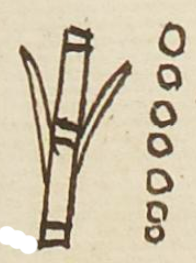Chicomacatl (MH483r)
This black-line drawing of the simplex glyph-plus-notation represents a personal name here, attested as a man's name. The notation is a series of unpainted circles running vertically to the right of the glyph for reed (acatl). The reed is segmented, akin to bamboo or the canes called carrizo in Mexican Spanish. Sometimes the expression of seven ones will be grouped into five and two. Here, the first five are slightly larger than the bottom two, but there is not a noticeable separation into two groupings of ones. The reed is also vertical and has two leaves, on on each side of the stalk, which has three horizontal rings, at the top, bottom, and middle. The reed has no colorant here.
Stephanie Wood
This is a calendrical name, drawn from the tonalpohuall, 260-day divinatory calendar, which played an important role in the Nahuas' religious views of the cosmos. Acatl was a propitious date: "They said the good days were Reed, Monkey, Crocodile, Eagle, House" (central Mexico, sixteenth century). See: Fr. Bernardino de Sahagún, Florentine Codex: General History of the Things of New Spain; Book 6 -- Rhetoric and Moral Philosophy, No. 14, Part 7, eds. and transl. Arthur J. O. Anderson and Charles E. Dibble (Santa Fe and Salt Lake City: School of American Research and the University of Utah, 1961), 129.
Alternatively, the name chicomacatl could relate to a medicinal herb, and the calendrical notation for Chicome Acatl was painted here to approximate the name of the herb.
Stephanie Wood
chicomacatl
Chicomacatl
Stephanie Wood
1560
Chicome Acatl, Seven Reed, reeds, plants, numbers, plantas, números, cañas, Chicomaca, nombres de hombres

Chicomacatl, a name, https://nahuatl.wired-humanities.org/content/chicomacatl-0
chicomacatl, a medicinal herb, https://nahuatl.wired-humanities.org/content/chicomacatl
chicome, seven, https://nahuatl.wired-humanities.org/content/chicome
aca(tl), reed, https://nahuatl.wired-humanities.org/content/acatl
Siete Caña (7-Caña), o una hierba medicinal(?)
Stephanie Wood
Matrícula de Huexotzinco, folio 483r, World Digital Library. https://www.loc.gov/resource/gdcwdl.wdl_15282/?sp=45&st=image.
This manuscript is hosted by the Library of Congress and the World Digital Library; used here with the Creative Commons, “Attribution-NonCommercial-ShareAlike 3.0 License” (CC-BY-NC-SAq 3.0).



